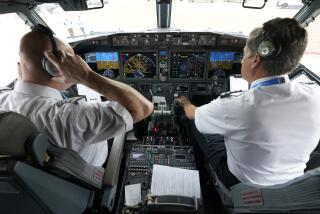A Private, and Perilous, Venture
Traveling by private plane has always carried a certain adventurous allure, a sense of prestige and privilege that even flying first-class in a commercial aircraft can’t match. And if you’re the one piloting the private plane, well, the world is your oyster.
Yet there’s an enhanced risk of danger involved as well, and one that tends to go almost unnoticed unless a celebrity such as John F. Kennedy Jr. or pro golfer Payne Stewart is involved.
But as we’re reminded by a pair of tragic incidents in the past few days--the July 4 crash of a small plane in San Dimas that claimed four lives, and another crash earlier in the week in Los Padres National Forest that killed six people in two planes--general aviation flying can be a risky proposition.
That’s the taking-off point for tonight’s A&E; special “Investigative Reports: Flying Blind” (10-11 p.m.), a rather bland cautionary tale narrated by Bill Kurtis.
About a half-million people pilot private planes each year in the U.S., and there are 2,000 serious crashes annually, according to “Flying Blind.” In this country alone, 600 people die each year in small planes. The program cites details of several multiple-fatality crashes of recent years including JFK Jr.’s in July 1999 and the Stewart crash in October ‘98, in which a loss of cabin pressure apparently killed the pilot and passengers, yet the plane continued flying for several hours.
But the most significant message tonight is that nearly 70% of private plane crashes are due to pilot error. You’d be surprised how many pilots simply run out of gas.
And then there’s the syndrome air-safety experts call “Get Home-itis,” in which pilots press on despite red flags usually relating to weather or equipment problems. This, combined with training that is frequently inadequate, proves a deadly combination far too often.
More to Read
Sign up for The Wild
We’ll help you find the best places to hike, bike and run, as well as the perfect silent spots for meditation and yoga.
You may occasionally receive promotional content from the Los Angeles Times.






